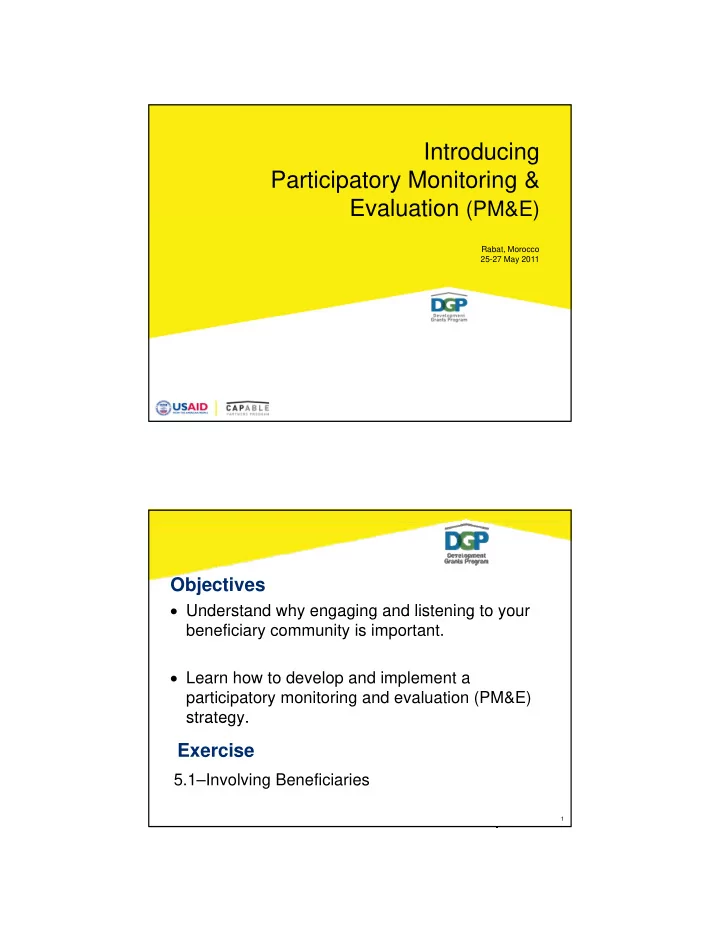

Introducing Participatory Monitoring & Evaluation (PM&E) Evaluation (PM&E) Rabat, Morocco 25-27 May 2011 Objectives • Understand why engaging and listening to your Understand why engaging and listening to your beneficiary community is important. • Learn how to develop and implement a participatory monitoring and evaluation (PM&E) strategy. strategy. Exercise 5.1–Involving Beneficiaries 1
What are the Core Principles of PM&E? • Consider primary stakeholders as active participants – not objects or mere sources of information • Build the capacity of local people to analyze, reflect and take action • Foster joint learning of stakeholders at various levels • Fuel commitment to taking corrective action(s) 2 Exercise 5.1 – Involving Beneficiaries Objective: Learn about examples of PM&E j p Tasks: 1. With your organization, discuss the way(s) you have involved and/or encouraged beneficiaries/stakeholders to participate in your M&E activities. 2. Please write each approach on a separate sticky note. Post on your flip chart. y p 3. Discuss the level of how ‘participatory’ each of these approaches is. 4. Be prepared to present several approaches to the plenary. 3
Levels of Beneficiary/Stakeholder Participation in M&E Activities High 7. Self Mobilization 6. Interactive 5. Functional 4. For material incentives 3. Consultation 2. Information giving 1. Passive Low 4 What is Participatory Monitoring? Involves local beneficiaries in measuring, recording, collecting, processing and communicating information 5
What is Participatory Evaluation? Involves local beneficiaries in analyzing data to assist your NGO in decision-making • May mean adjusting and redefining project or program objectives, revising implementation and/or re-allocating resources . 6 Why is PM&E Important? • Acknowledges that people in beneficiary Acknowledges that people in beneficiary communities are the ones who know the most about the challenges in their lives. • Strengthens the ability of people and local organizations to analyze, plan, consider changes make decisions and act changes, make decisions and act. • Strengthens relations between your organization and the community and creates trust. 7
Why is PM&E Important? • Increases the technical and administrative capacities of all involved. • Yields data that are useful and gives everyone involved a sense of ownership of the results. o ed a se se o o e s p o t e esu ts 8 Conventional M&E vs PM&E Conventional M&E • Involves internal or external experts who measure performance against pre-set indicators, using standardized procedures and tools Participatory M&E • Engages key project stakeholders more actively in assessing the progress of their project and, in particular, the achievement of results 9
What are Challenges to Doing PM&E? Ensuring • participants/beneficiaries are involved in a meaningful way • enough incentives so that participants/ beneficiaries’ time and effort are worth it beneficiaries time and effort are worth it • sufficient commitment, budget, planning and time for PM&E activities allotted 10 Other Challenges… • Too much faith in numeric (quantitative) Too much faith in numeric (quantitative) indicators, not enough in complementary qualitative data • Lack of trust, confidence and familiarity with PM&E approaches • Unclear responsibilities, objectives, timeline • Plans that are too detailed, not very realistic or practical 11
What Works? • Tailoring the PM&E approach to match the Tailoring the PM&E approach to match the situation and culture • Clearly defining responsibilities, resources, plans and timeline • Working with participants to set priorities and choose the focus of their monitoring activities • Providing real benefits and incentives for participants/stakeholders 12 Steps in a PM&E Process... • Recruit participants • Review project/program objectives • Plan what to measure and how • Identify measurements to assess results or show • Identify measurements to assess results or show extent of progress achieved 13
Steps in the PM&E Process... • Develop measurement indicators • Collect data at regular intervals • Organize and analyze data • Report on findings to beneficiaries, communities, R t fi di t b fi i i iti governments, donors, etc. • Make decisions, adjustments as necessary 14 Role of NGO Staff • Show rather than tell • Guide rather than impose • Collaborate rather than dictate • Listen rather than lecture • Interact rather than control 15
Questions and Comments ? 16
Recommend
More recommend